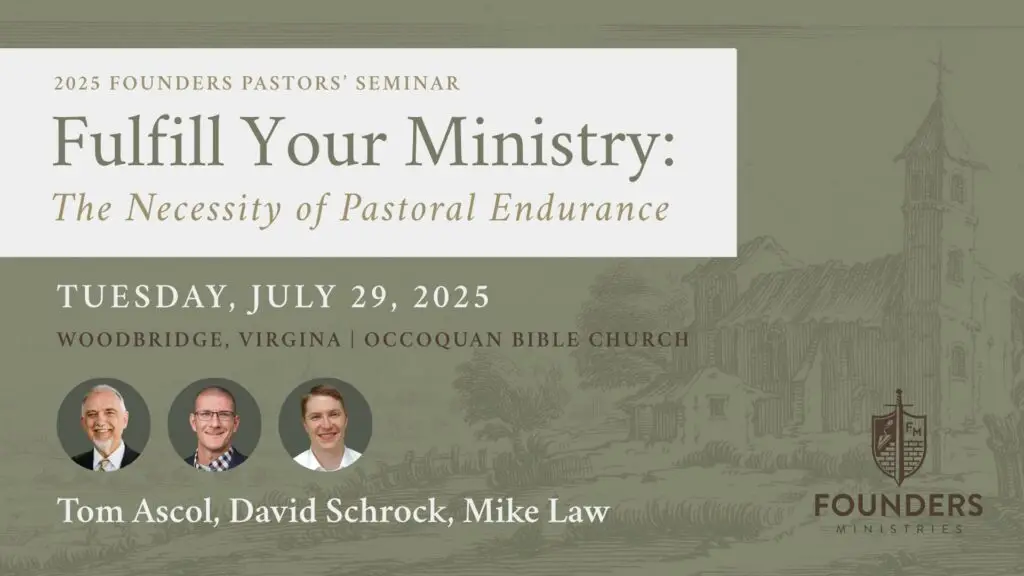THE ISSUE OF BAPTISM—who should be baptized and why—is part of a wider debate concerning the nature of the church. Is the church to be defined in terms of believers and their children or as composed of believers only, whether adults or children? And the debate about the nature of the church is part of a yet wider debate as to the relationship between the Old and New Testaments. How is this to be understood? Is there such a fundamental continuity that the new covenant is but a new administration of the Abrahamic covenant (Genesis 17:9–14). Or is it really new in such a way that administration is woefully inadequate to describe it because it does not do justice to its radical, eschatological newness?
It is unfortunate that the key issue of the relationship between the Testaments is often not addressed in the debate over baptism. Too often the relationship is assumed without being considered as an essential preliminary to the debate itself. Yet how the relationship is understood will inevitably influence the exegesis of particular texts and determine the shape of any theology of baptism that lays claim to be considered biblical. John S. Feinberg is surely on the right track when he states:
Evangelicals agree that God has spoken and that the Bible is his word. But God has not revealed all of his word at once. How are we to relate what he said through the prophets of old to what has been revealed through his apostles? Without an answer to this question it is difficult to know how to use both Testaments in formulating either doctrine or practice. An example of a doctrinal issue that hinges on this question is one’s understanding of the church. Are Christians to formulate their concept of the church on the basis of both Testaments, claiming so much continuity between the people of God that one may see the church in the OT? Or is there such a discontinuity between Israel and the church that one’s understanding of the church must be formed solely on the basis of the NT?1
Though Feinberg overstates the issue in terms of an either/or—continuity or discontinuity—without allowing that there can be continuity and discontinuity within a schema of promise and fulfillment, in his basic contention he is certainly correct. One’s doctrine of the church is related to how one understands the relationship between the two Testaments. This is recognized by Robert L. Reymond:
It is clear that both antipaedobaptists and paedobaptists argue by way of inference from more fundamental theological premises, focused largely on the relationship between the testaments, with the former stressing a dispensational discontinuity at this point in the covenant of grace, the latter stressing the continuity of the covenant of grace respecting this matter.2
How fundamental the assumption of continuity is in the baptismal debate can be seen from the proposition of Charles Hodge: “If the Church is one under both dispensations; if infants were members of the Church under the theocracy, then they are new members of the Church now, unless the contrary can be proved.”3
It is this assumption that enables Reformed paedobaptists to jump so easily from the circumcision of Abraham’s household (Genesis 17) to the baptism of the infant seed of believers now, and to be so untroubled by the lack of positive evidence of the baptism of infants in the New Testament. Indeed, the silence of the New Testament is seen as a positive virtue by Pierre Charles Marcel:
In reality the silence of the New Testament regarding the baptism of infants militates in favor of, rather than against, this practice. To overthrow completely notions so vital, pressed for more than two thousand years on the soul of the people, to withdraw from children the sacrament of admission into the covenant, the Apostolic Church ought to have received from the Lord an explicit prohibition, so revolutionary in itself, that a record of it would have been preserved in the New Testament.4
Now the question that needs to be put is this: “Is there reason to believe that Reformed paedobaptists have overlooked a key element in redemptive history that calls into question their common assumption that it is possible to jump from circumcision to the baptism of infants?” I believe there is. It is the ministry of John the Baptist which we must now consider.
The place of John the Baptist in redemptive history
It is significant, as F. F. Bruce observes, that all four Gospels “preface their narrative of the ministry of Jesus with a brief summary of John, and the evidence of Acts suggests that this reflects primitive Christian preaching.”5 Mark’s Gospel, indeed, sees the ministry of the Baptist as marking “the beginning of the gospel about Jesus Christ, the Son of God” (1:1). Peter, too, in the household of Cornelius emphasizes the place of John in redemptive history: “You know what has happened throughout, Judea, beginning in Galilee after the baptism that John preached—how God anointed Jesus of Nazareth with the Holy Spirit and power …” (Acts 10:37–38). Paul also recognizes the pivotal significance of the Baptist’s ministry when addressing the synagogue at Pisidian Antioch: “Before the coming of Jesus, John preached repentance and baptism to all the people of Israel” (Acts 13:24).
It is clear that in the early Church the ministry of John the Baptist is seen as marking the boundary between the age of the promise of the kingdom of God and the arrival of the kingdom in the person of Jesus-Messiah. This is true, according to the testimony of Acts, for both the key apostles—for Peter, the apostle to the Jews, and Paul, the apostle to the Gentiles.
It is also clear that neither Peter nor Paul were the originators of this view of John the Baptist’s place in redemptive history. The Gospels uniformly trace it back to Jesus Himself. It is He who assigns to John his place in the unfolding of the story of redemption.
When we examine the four Gospels we cannot but be struck by the space and the attention that are given to the Baptist. From this testimony we may extract a number of features:
(1) He is the forerunner of the Messiah
He, according to Jesus, is “the one about whom it is written: ‘I will send my messenger ahead of you, who will prepare your way before you’ ” (Matthew 11:10, quoting Malachi 3:1; cf. Also Exodus 23:20). In Johhanine terms he “came as a witness to testify concerning that light … He himself was not the light; he came only as a witness of the light” (John 1:7–8). Other prophets before John “spoke of the grace that was to come” (1 Peter 1:10), but only John had the privilege of being the forerunner of the promised Messiah.
(2) He is more than a prophet
In what sense is the Baptist designated by Jesus as “more than prophet” (Matthew 11:10)? Why is he singled out from the rest of the Old Testament prophets in this way? D. A. Carson supplies us with the answer: “Not only was he, like other OT prophets, a direct spokesman for God to call the nation to repentance, but he himself was the subject of prophecy—the one who, according to Scripture, would announce the day of Yahweh.”6 John had borne witness to Jesus (Matthew 3:11–12; John 1:29). Jesus now bears witness to him. To no other prophet does Jesus bear such witness, for only John has the unique relationship to Jesus that he does.
(3) He is the climactic point of all OT prophecy
“For,” says Jesus, “all the Prophets and the Law prophesied until John” (Matthew 11:13). Until could include or exclude John, but the following verse makes it clear that John is to be reckoned among the prophets, for he is the Elijah who was to come. The whole prophetic corpus reaches its climax in John the Baptist. He is the last in the sequence that cumulatively builds up to the advent of Messiah. All the prophets before John say that Messiah is coming, but John is able to say that he has come (John 1:29).
It is clear that John occupies a unique place in the biblical story—as unique in its way as that occupied by Mary, the mother of Jesus. As she was “highly favored” (Luke 1:28) so, too, was John the Baptist. For did not the Lord Jesus declare as much, prefacing his testimony with a solemn “Amen”? “I tell you the truth: Among those born of women there has not risen anyone greater than John the Baptist” (Matthew 11:11).
Yet our Lord immediately adds that “he who is least in the kingdom of heaven is greater than he.” With these words he underscores the radical, epochal disjunction that there is between the kingdom of God, now arriving with and in Jesus Messiah, and the whole prophetic period that preceded it. John may be the climactic point of all Old Testament prophecy, but the least in the kingdom of heaven is greater than he. This does not mean that John is excluded from the kingdom as an individual, no more than any of the Old Testament saints were. What it does mean is that with respect to the development of God’s redemptive plan John, in his role as forerunner, is outside the kingdom of heaven. “He is the last of the old order, as the subsequent identification with Elijah (v. 14) will make clear.”7 Thus even the least in the kingdom of heaven is greater than John. Unlike John who is in prison awaiting his end, he or she would see the kingdom coming in power and thus be able to point to Jesus the King without the ambiguity which John experienced at this point (Matthew 11:2–3).
(4) John calls out a remnant people for the Lord
John called upon Israel to repent in view of the soon coming judgment of God when his wrath would be poured out upon a disobedient nation. He calls for a radical turning to God, a returning to God from their rebellion back to true covenant obedience. This is the burden of his preaching: “Repent, for the kingdom of heaven is near” (Matthew 3:2). And his call is urgent, for “the axe is already at the root of the trees” (v. 10).
To those who responded to his message John administered baptism in the Jordan River. Those who were baptized confessed their sins (Matthew 3:6) and were committed by their baptism to “produce fruit in keeping with repentance” (v. 8).
John’s baptism was a radical innovation. It was administered to Jews, not proselytes from among the Gentiles. It was a once only rite, so it is marked off from the repeated lustrations of contemporary Judaism in general and from those practiced in the Qumran community in particular. And, it was administered to persons already circumcised.
According to John, descent from Abraham and status as members of the community, were of no avail unless there was genuine repentance issuing in real moral fruit in one’s life (vv. 8–9). Not only may God narrow Israel down to a remnant—as He did more than once in the course of Israel’s history—but He may also raise up true children of Israel from “these stones,” perhaps, as Carson suggests, stones lying in the river bed.8(Both Hebrew and Aramaic have a pun on “children” and “stones”).
When John baptized Jesus he associated Him with the remnant people of Israel. Jesus underwent baptism at the hands of John, not because He had sins to confess but because in undergoing the rite He identified Himself as the “Suffering Servant” with those He came to save. In so doing, both John and Jesus fulfilled all righteousness (v. 15; note that “us” refers to John and Jesus). They were together obeying God’s righteous will.
John’s baptism, then, was baptism for a remnant—the baptism of a people from within the nation of Israel, who were preparing the way for the Lord (Mark 1:2–3). And the baptism that Jesus permitted his disciples to administer (John 4:2) seems to have had much the same significance (John 3:22–26).
The Significance of John’s Baptism in the continuing Debate
As we have already noticed the baptism of John does not figure very much in the continuing debate about baptism. Reformed paedobaptists simply ignore it in their concern to establish the proposition that the circumcision of infants is now replaced by the baptism of infants. Reformed Baptists have responded to their position by arguing that the antitype of circumcision in the flesh is the circumcision of the heart, that is regeneration. Typical of their response is that of C. H. Spurgeon. In a sermon on “Consecration to God Illustrated by Abraham’s Circumcision” he said:
It is often said that the ordinance of baptism is analogous to the ordinance of circumcision. I will not controvert that point although the statement may be questioned. Supposing it be, let me urge on every believer here to see to it that in his own soul he realizes the spiritual meaning both of circumcision and baptism and then consider the outward rites. For the thing specified is vastly more important than the sign. “Well,” saith one, “a difficulty suggests itself as to your views for an argument is often drawn from this fact that inasmuch as Abraham must circumcise all his seed we ought to baptize all our children.” Now observe the type and interpret it not according to prejudice but according to Scripture—in the type the seed of Abraham is circumcised—you draw the inference that all typified by the seed of Abraham ought to be baptized, and I do not cavil at the conclusion, but I ask you, who are the true seed of Abraham? Paul answers in Romans 4:8, “They which are the children of the flesh, these are not the children of God; but the children of the promise are counted for the seed.” As many as believe on the Lord Jesus Christ, whether they be Jews or Gentiles, are Abraham’s seed. Whether eight days old in grace, or more or less, everyone of Abraham’s seed has a right to Baptism, but I deny that the unregenerate whether children or adults are the spiritual seed of Abraham … The answering person in type to the seed of Abraham is, by the confession of everybody, the believer. And the believer ought, seeing that he is buried with Christ spiritually, to avow that fact by his public baptism in water according to the Savior’s own precept and example.9
Spurgeon is a good model to follow, which I did in my Children of Abraham.10 However, further reflection has brought me to see that simply to respond to the circumcision/baptism analogy so fundamental to the paedobaptist case for infant baptism fails to do justice to the place of John the Baptist in redemptive history. As far as it goes Spurgeon’s reply is adequate, but it is a response to an agenda set by Reformed paedobaptists and, in effect, it allows them to skip over the ministry of the Baptist as if it had no significance for the on-going debate about the subjects of baptism. But it has, as I shall now attempt to show.
(1) John’s baptism is an innovation
This point has already been made, but it now requires further consideration. When, in the temple courts the chief priests and elders question Jesus’ right to cleanse the temple (Matthew 21:12–13), asking him “By what authority are you doing these things?” and “Who gave you this authority?” His counter question puts them on the spot. Jesus replied, “I will tell you by what authority I am doing these things. John’s baptism—where did it come from? Was it from heaven, or from men?” (vv. 23–25).
The dilemma of Jesus’ opponents is obvious. If John’s baptism was from heaven then they should have believed the message he preached and submitted themselves to the baptism he administered. If they admitted that it was from men they faced an explosion of popular wrath, for “the people … all hold that John was a prophet”—that is he is a God-sent messenger whose authority is “from heaven” (verse 26). In the light of this interaction between our Lord and the leaders of the Jews it seems right to conclude that John’s baptism is an innovation. It is John’s baptism, not an ancient rite with its roots in Jewish lustrations. It is not proselyte baptism, assuming that it was being practiced at the time. John’s baptism is administered to Jews, not to Gentile converts to Judaism, as proselyte baptism was. John’s baptism of repentance is a radical innovation instituted on his own (derived) authority as a prophet sent by God. It marks a new development in the unfolding history of redemption, for John baptizes Jews who are willing to enter God’s remnant people through a baptism of repentance. It is therefore rightly described as John’s baptism.
A further point is to be noticed. We have already remarked on the connection between the baptizing ministry of John and that of the disciples of Jesus. Here in the dispute in the temple courts Jesus links his work with that of John the Baptist. His assumption is that they both act upon the same authority. Their commission has a common source—it is “from heaven.” Thus, as Floyd V. Filson points out, “Jesus knows that his work and John’s are connected, and that the Jewish leaders, in failing to see that God had sent John, had forfeited their right to judge John’s successor.”11 The importance of this point will become evident later.
(2) John baptizes already circumcised people
Again we have already noticed this fact, but now we need to draw out its implication. In baptizing people who had already been circumcised, it is very likely that John does not see baptism as replacing circumcision, but as being a new rite that comes in alongside it. This new rite is appropriate as a sign of entry into the remnant people of God in a way that circumcision is not. Whatever the spiritual reality that circumcision points to—the circumcision of the heart—the fact remains that it is the identifying sign of the Jewish nation, not of the remnant within that nation. One has only to compare what was required for circumcision with what John looks for in those whom he baptizes to appreciate how different the two rites are from each other. “For the generations to come every male among you who is eight days old must be circumcised, including those born in your household or bought with money from a foreigner—those who are not your offspring. Whether born in your household or bought with your money, they must be circumcised” (Genesis 17:12–13). When we read the following the contrast is very stark indeed: “Confessing their sins, they were baptized by him in the Jordan River” (Matthew 3:6). A baptism of repentance for the forgiveness of sins (Mark 1:5), not circumcision, is the appropriate sign of the remnant called out through the preaching of the Baptist.
If the two rites—circumcision and baptism—differ so markedly from one another, and in where they are placed in the unfolding of God’s redemptive plan, it is not surprising that John and man should not have seen baptism as replacing circumcision. Nor is it surprising that in the early church Jewish believers practiced circumcision and administered baptism. There is not a hint in the New Testament that Jewish believers ceased to have their male children circumcised. Indeed, the evidence is that even Paul, who so strongly resisted any attempt to impose circumcision upon Gentile believers, agreed that it should continue among his fellow Jewish believers. Acts 21:21 mentions that a false report about Paul had been spread among the “many thousands” of Jews who had believed (v. 20). This was that he was teaching “all the Jews who live among the Gentiles to run away from Moses, telling them not to circumcise their children or live according to our customs.” At the suggestion of James and the elders of the Jerusalem church, Paul publicly demonstrated the falsity of the report by joining in the purification rites of four men who had mad a vow. He also paid their expenses. The intended result is made plain: “Then everybody will know there is no truth in these reports about you, but that you yourself are living in obedience to the law” (v. 24b).
In continuing to have their male children circumcised, believing Jewish parents clearly took their cue from John the Baptist who did not see his baptism as replacing circumcision. Now, if this is the case, why should we expect that the two rites of circumcision and baptism were administered to male infants? Circumcision certainly, but not baptism.
Douglas Wilson, a strong paedobaptist, rightly perceives the problem faced by those who continue to advocate the classic Reformed case for infant baptism. He observes that when the Baptist claim that there are no examples of infant baptism in the New Testament is challenged “it is challenged with inadequate arguments from silence—the purported babies of the Philippian jailer being one example. If we only produce examples in the New Testament where maybe they baptized infants, we may legitimately conclude that maybe we should too. This is hardly a solid foundation upon which to build a basic parental duty—if duty it is. All too often paedobaptists grant that the New Testament offers no examples of infant baptism, and then seek to establish their case on grounds of continuity with the Old Testament.”12 While I do not find Wilson’s arguments for infant baptism convincing, his admission of the inadequacy of the classic case is significant, as also is his recognition that “the transition from the older administration to the new took almost half a century.”13 However, Wilson fails to notice the significance of John the Baptist’s place in redemptive history. Had he done so he would have begun to appreciate that there are other weaknesses in the classic case for infant baptism.
(3) John did not baptize infants
The evidence is very clear that John did not baptize infants. His baptism is administered to those who confess their sins. By its very nature as the identifying sign of a people turned again to God—a remnant people—it requires repentance. It is “a baptism of repentance for the forgiveness of sins” (Mark 1:4). Both Matthew and Mark emphasize the element of confession: “confessing their sins, they [the baptizands] were baptized by him [John the Baptist] in the Jordan River” (Matthew 3:6; Mark 1:5). Nothing in the text suggests that they confessed the sins of their infants or that their infants were baptized with them. William Hendriksen, a paedobaptist comments, “Without confession of sins no baptism! For those who truthfully repented of their evil state and wicked conduct baptism … was a visible sign and seal of invisible grace (cf. Romans 4;11), the grace of forgiveness and adoption into God’s family.”14 This is a statement to which all Baptists could give hearty assent.
Those who are capable of confessing their sins are clearly not infants who cannot yet talk, as Francis Turretin clearly recognizes. He writes: “John admitted none to baptism but those who confessed their sins; because his business was to baptize adults.”15
We have already noticed that the disciples of Jesus administered a baptism that was identical with that practiced by John—a baptism of disciples who commit themselves in baptism to the lifestyle of God’s remnant people (John 4:1–2). We have also noticed that our Lord acknowledged that His work and that of John are intimately connected. He avers to the Jewish religious leaders that John’s baptism has behind it the same authority as His own dramatic act in cleansing the temple—it is from heaven. Clearly, then, He was endorsing a baptism that was not for infants, but only for those capable of confessing their sins.
An important implication follows from this. If John the Baptist only baptized those who were capable of confessing their sins, and if the disciples of our Lord followed the same practice with His approval, why should it be so difficult to believe that the apostolic Christ did not practice infant baptism?
Concluding observations
I shall now draw together the threads of my argument thus far. My hope is that my paper may help to move the debate over the subjects of baptism onto new and more fruitful ground.
(1) Paedobaptists need to do justice to the place of John the Baptist in redemptive history
To go on maintaining that it is possible to make a simple move from the circumcision of infant males to the baptism of infants is to ignore the significance of the ministry of the Baptist. However, as I have attempted to show, responsible biblical/theological exegesis will not allow us to do so. Given the way in which the Gospel writers see John as the pivotal figure in the transition from the old dispensation to the new, eschatological dispensation, and given the clear endorsement of his ministry by our Lord, it is no longer helpful for paedobaptists to argue for infant baptism as if John the Baptist never existed. He did, and so proper weight needs to be given to his role in redemptive history.
For their part, Reformed Baptists, if they give proper weight to John’s role in redemptive history, need not allow their paedobaptist friends to set the agenda as they have done in the past. In the light of John’s ministry the neat schema of circumcision/baptism is to be questioned. For in baptizing only those capable of confessing their sins, John clearly abandons the principle of you and your seed (Genesis 17:10). Furthermore our Lord, in endorsing John’s baptism, clearly did the same.
According to the paedobaptist argument, John should have baptized infants as well as adults since he would, as a Jew, have accepted the principle of “thee and thy seed.” Yet he did not baptize infants. How do paedobaptists account for this? I suggest that on their own premises they are caught in a very difficult position. They could maintain, firstly, that since John did not baptize infants without a clear command not to do so, he had acted without divine authorization. This is unthinkable in the light of his mission as God’s messenger.
Secondly, paedobaptists could argue that in the case of his repentance baptism the principle (of “thee and thy seed”) did not apply. If they choose to argue in this way they must show why the principle should not apply to Christian baptism which is also, among other things, a repentance baptism (e.g. Acts 2:38).
It seems to me that there can be no escape for paedobaptists from the dilemma posed by John’s baptism. Either John baptized infants (which they admit that he did not) or he did not [uphold] the covenant principle of “thee and thy seed.” If he did not uphold this principle, most likely because it was set aside by the repentance baptism that he was authorized “from heaven” to administer, then why should it be insisted that our Lord and his apostles continued to uphold it?
To insist that the principle of “thee and thy seed” is meant to continue in force beyond the ministry of John the Baptist is to assume that the clock of redemptive history be turned back and the principle be re-established, having for a time been set aside. But this would be without precedent in Scripture. The movement of redemptive history is progressive and cumulative, not retrogressive. The repentance baptism of John leads on to the repentance-baptism of the first disciples of Jesus and his apostles, not away from it.
A further point remains to be made. It is this. Paedobaptists accuse their Baptist brethren of a lack of generosity towards infants. Typical is Professor John Murray. He writes,
If children born of the faithful were given the sign and seal of the covenant, and therefore the richest blessings which the covenant disclosed, if the New Testament economy is the elaboration and extension of this covenant of which circumcision was the sign, are we to believe that infants in this age are excluded from that which was provided by the Abrahamic covenants. In other words, are we to believe that infants may not properly be given the sign of that blessing which is enshrined in the new covenant? Is the new covenant in this respect less generous than was the Abrahamic?16
This ungenerous, hardhearted Baptist would reply that he is no less restrictive than John the Baptist! In other words, if due attention is paid to the practice of John the Baptist the paedobaptist appeal to our emotions loses its force.
(2) The silence of the New Testament as to the baptism of infants can be given a more convincing explanation than is the case in Reformed paedobaptism
When challenged by the average dispensational Baptist about this silence the instructed paedobaptist is unfazed. The silence is just what one would expect. In the absence of a clear command in the New Testament rescinding the giving of the covenant sign to infants we should expect that sign, now baptism in water, to be given to infants, both male and female.
But is there not a more convincing explanation of the silence of the New Testament? And does not this do justice to the history of redemptive revelation in a way that traditional paedobaptist apologetic fails to do? I submit that the silence of the record of John’s ministry as to the baptizing of infants is a far better explanation of the silence of the New Testament about infant baptism. The silence is eloquent testimony to the fact that the principle of “thee and thy seed” was set aside by the baptism of John, a baptism which being “from heaven” had divine authorization behind it. As such it required no specific command, for the authorized practice and the confession of sins that was demanded, was command enough. In short, the silence of the Baptist is the silence that breaks the silence![1]
1 John S. Feinberg (ed.), Continuity and Discontinuity—Perspectives on the Relationship between the Old and New Testaments. Essays in Honor of S. Lewis Johnson, Jr., (Crossway Books, Westchester, Illinois, 1988), xi.
2 Robert L. Reymond, New Systematic Theology of the Christian Faith, (Thomas Nelson, Nashville, TN, 1998), 936.
3 Charles Hodge, Systematic Theology, vol. 3, (James Clarke, London, 1960), 555.
4 Pierre Charles Marcel, The Biblical Doctrine of Infant Baptism, (trans. Philip Edgcumbe Hughes, James Clarke, London, 1953), 152.
5 F. F. Bruce, New Testament History, (Doubleday, Garden City, New York, 1972), 152.
6 D. A. Carson, Matthew in Frank E. Gaebelein (ed.), The Expositor’s Bible Commentary, vol. 8, (Zondervan, Grand Rapids, 1984), 263–4.
7 R. T. France, Matthew, in Tyndale New Testament Commentaries, (InterVarsity Press, Leicester, 1985), 194.
8 Carson, op. Cit., 103.
9 C. H. Spurgeon, The Metropolitan Tabernacle Pulpit, vol. 4, (Passmore and Alabaster, London, 1868), vol. 14, 695–6.
10 David Kingdon, Children of Abraham—a Reformed Baptist View of Baptism, the Covenant, and Children, (Carey Press, Haywards Heath, 1973).
11 Floyd V. Filson, The Gospel According to Saint Matthew, in Black’s New Testament Commentaries, (A. and C. Black, London, second edition, 1971), 226.
12 “Circumcision in the New Covenant,” Christianity and Society, vol. 4, number 4, October 1994, pp. 22–28. The quotation is from p. 22.
13 Ibid., 26.
14 William Hendriksen, Matthew, in New Testament Commentary, (Banner of Truth, Edinburgh, 1974), 200.
15 Francis Turretin, Institutes of Thelogy, Section IV, question 22, quoted T. E. Watson, Baptism not for Infants, (1962 reprinted, Henry Walter, Worthing, 1972), 22.
16 John Murray, Christian Baptism, (Presbyterian and Reformed, Philadelphia, 1962), 51–2.
[1] David Kingdon, “John the Baptist—The Silence That Breaks the Silence,” The Founders Journal: Reflections on Twenty Years of Founders Ministries, Fall, no. 50 (2002): 21–30.





























